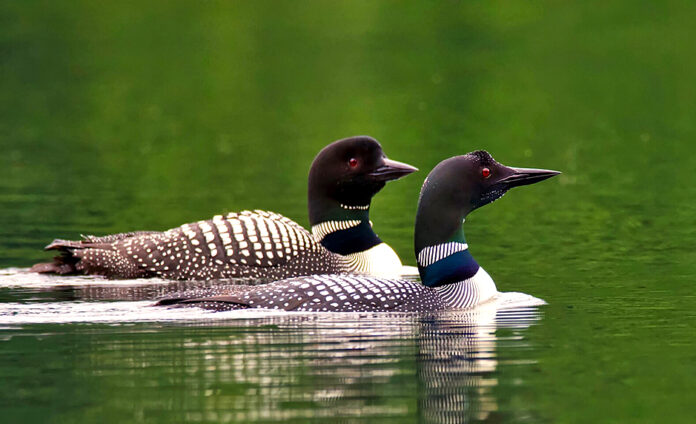A migratory diver of the loon family, the common loon (Gavia immer) has been important to people living in the Great Lakes region for hundreds, if not thousands, of years. Its striking calls and black-and-white summer plumage have made it an emblem of Minnesota, where more of the birds live than in any other state except Alaska. The loon became Minnesota’s state bird in 1961.
Adult loons weigh eight to twelve pounds and are shaped like torpedoes. Their summer plumage is a spotted white and black, with iridescence on the head; in winter, that coloring changes to gray and white. Males can be a bit larger than females, but in all other ways they are identical.
Loons have four calls: the yodel, the wail, the hoot, and the tremolo. They live on lakes in central and northern Minnesota but migrate south every September to the Atlantic coast (their northern range includes the northern US and Canada) before returning north in the spring. Their bones, unlike those of most birds, are not hollow, allowing them to dive deep underwater for their food: small fish, minnows, amphibians, insects, crayfish, and mollusks.
The loon (maang in Ojibwemowin) is culturally important to Ojibwe people. It plays a role in some versions of Ojibwe creation stories, while other legends connect Maang to Nanaboozho, an Ojibwe cultural hero. It is said that when Maang calls in the rain at dusk, the bird is calling for Nanaboozho. Many Ojibwe people are members of the Maang Doodem (Loon Clan), and Maang is sacred to them. It is taboo for a member of the Maang Doodem to harm a loon or to marry another member of the clan.
In Ojibwe culture, clans are named after animals (or parts of animals) and perform distinctive roles. The members of bird clans, such as the Crane and the Loon, take on civil leadership roles. Members of the Maang Doodem historically served as diplomats, often leading negotiations until a member of the Crane Clan (Ajijaak Doodem) offered final decisions. “Leading with your Loon” is an Ojibwe teaching today that encourages people to be diplomatic with others. Dakota people call the loon Mdóza and have incorporated some elements of it into their culture as well.
As white settlers entered Minnesota in the 1800s, the loon population declined due to hunting and habitat destruction. The Migratory Bird Treaty Act of 1918 prohibited the taking of loons without the authorization of the Department of the Interior’s Fish and Wildlife Service. Though protected from overhunting, loon habitat continued to decline in the 1920s due to residential development and summer vacationers in northern Minnesota. In the 1930s, loons began to disappear from central and southern Minnesota lakes.
The loon became Minnesota’s state bird in 1961. Spurred by the work of Dr. Judith McIntyre and the Minnesota Department of Natural Resources, programs focused on protecting and learning more about the state’s loons began in the 1970s. In 1977, Minnesota’s Nongame Wildlife Program started raising funds to conserve Minnesota’s nongame species. The investment paid off. By 1989, the loon was struggling across the US but not in Minnesota, where there were an estimated 10,000 loons for the state’s 10,000 lakes.
To gather more information about the state’s loon population, the Minnesota Department of Natural Resources began a loon-monitoring program in 1994. After the 2010 Deepwater Horizon oil rig explosion killed thousands of loons overwintering in the Gulf of Mexico, a settlement awarded Minnesota $7.52 million as compensation for injury to its natural resources. The money has been used to support Minnesota’s Loon Restoration Project, which focuses on eight counties in north-central Minnesota.

The loon is a Minnesota icon, and organizations have adopted it as their emblem. When the Minnesota State Lottery began in 1989, it used the loon as its logo to remind people that some lottery earnings supported state conservation programs. In 2002 a loon design became an option on Minnesota license plates, and in 2005, it was put on the state quarter. The Minnesota United FC, Minnesota’s professional men’s soccer club, started using a stylized loon logo in 2013. The team is often called “the Loons.” And in May 2024, Minnesota adopted a new state seal featuring a loon at its center.
Also in 2024, the International Union for Conservation of Nature (IUCN) rated the loon a species of “Least Concern” for extinction, and the bird continued to return to its range south of the Twin Cities. In spite of these gains, however, climate change, pollution, habitat loss, disturbance by humans, and use of lead fishing weights continue to threaten the loon population in Minnesota.
For more information on this topic, check out the original entry on MNopedia.
